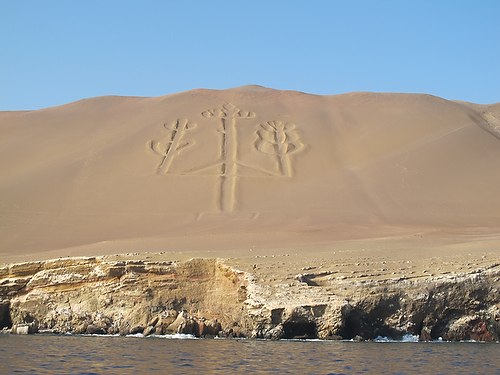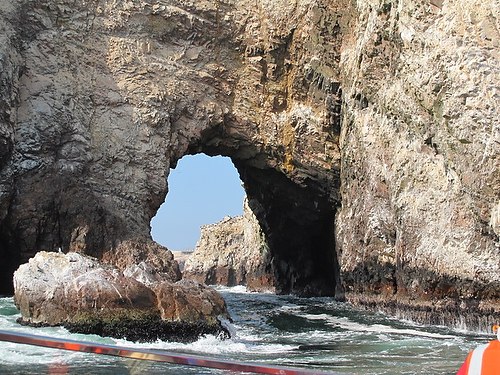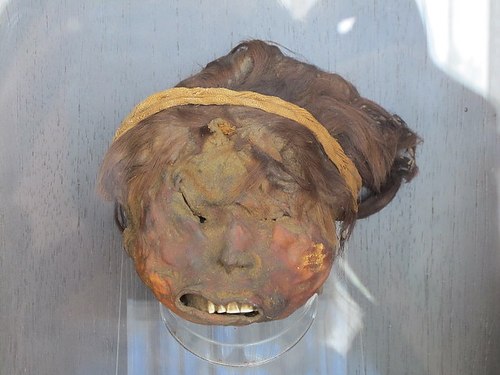PARACAS, Peru – The pungent scent of the sea washes over the landscape like the rhythmic waves, and I contemplate the pleasure of lingering here in the peaceful beauty of the Paracas Hotel and enjoying a sumptuous breakfast buffet. But I’m scheduled for the first boat to the Ballestas Isles, and the penguins await.
I gather sweater and sunglasses and hat and head for the pier, where 22 people are buckling up with lifejackets and taking their seat aboard our skiff.
As if to see us off, a line of four Peruvian pelicans sails by just over the sparkling surface of the water in search of prey.
I sat next to Jose, one of the pilots from Tikariy Tours, and asked him what we were likely to see. We had been told from the start that, because it’s wintertime here in Peru, we won’t see the spectacle of the masses of breeding sea lions, as they’ve migrated for the season to an island that’s off-limits for conservation reasons. Our guide, Ana de la Cruz, is busy with a family in the back, so I ask Juan what we’re likely to see in the off season.
He pulls out a handy birding guide and begins to point out the highlights: the Inca tern, with its bright red feet and winsome white facial decorations; the endangered Humboldt penguin, at just over 2 feet tall when full-grown; three different types of cormorants and two types of oystercatchers; and the Peruvian booby, whose more famous blue-footed relative can be seen here in the summer months, but not today.
Our boat speeds past the silky golden dunes of Paracas National Reserve toward the islands, slamming periodically against the water in such a way I’m glad I held off on the buffet. Suddenly it slows down and as I look landward, I see an amazing sight: a 700-foot image resembling a candelabra etched into the side of the dune.

Ana tells us there are many theories as to the origins of this mysterious geoglyph, but nobody really knows. Some believe it to be the work of the Paracas people who originally inhabited this region and used it as a navigational device. Others think represents the sacred cactus of the Nazcas, whose mysterious Nazca Lines lie in a direct line south. Still others believe it’s the more recent creation of the José de San Martin expedition. San Martin is considered the liberator of Peru and passed by here the year before the war for independence from Spain. Proponents of this theory like to point to the triangular figure incorporated in the design and say it’s a Masonic symbol, since San Martin was a follower of the Freemasons.
Whatever its origins, the fact that the geoglyph has withstood the centuries is in itself a story worth telling. Its position on the side of the dune mostly protects it from the fierce winds, or paracas, that sweep this region. Even the occasional winds that reach it only reinforce the lines by blowing more sand up onto their calcified surface, Ana explains. Its resilience was dramatically illustrated a few years ago when a pair of young vandals decided to slide down the hills and left tracks in the ancient design. The wind eventually removed most traces of their tracks and restored the design.
Our boat once again heads southward and soon the ruggedly picturesque form of the first island emerges into view. The rocks have been worn away by centuries of the battering waves to create arches and bridges and fantastical shapes. Soon an amazing sight greets our eyes – those crags are alive with the squawking, restless forms of birds. We begin to make out their forms and Jose points them out to me – “look, a neotropical cormorant! Those over there are Inca terns – see the eye marking?”
Finally the boat pulled into a small cove and silenced the engine. Here, in a little recess of jagged stone, were the stars of the show, descending from their nests: a family of Humboldt penguins, waddling winsomely down the slope to find some dinner.
Something about a penguin truly warms the heart, and these were no exception. Their numbers have taken a steep decline in recent years, however, as have to a lesser degree the marine life in general in the region. Part of the problem has been overfishing and water contamination from nearby fishmeal factories, visitors and residents. Also, the area has been buffeted by El Niño, a series of climate phenomena that raised the water temperature to unprecedented highs and decimated the fish that the birds count on to survive.
Nonetheless, the vast numbers continue to impress; the islands are literally bristling with their birdy forms. Today we were able to observe the languid forms of the wrinkle-faced Sothern sea lions basking on the warm sunny rocks, but in the summer months from December through March, they provide a much more lively spectacle as they gather by the thousands on the beaches here and raise their young.
The two-hour tour was over before we knew it, and it was time for that hearty buffet. I also got an unexpected tour of Paracas Hotel’s extensive collection of antiquities from the Paracas and Nazca sites, including two thousand-year-old textiles, beautifully painted pottery and a horrifyingly distorted trophy head, the actual head of a defeated warrior with eyes removed and lips sealed with cactus needles in the traditional way.
These heads were carried about on a warrior’s belt, perhaps to convey the vanquished foe’s enemy to his victor, explained Raul Pino, a hotel staffer who, as son of historian and guide Raul Pino of Pino Tours, is a fount of fascinating information about the ancient cultures of Peru. He showed me examples of Paracas pottery that depicted a trophy head in the hand of a warrior, gripped by the hair. Indeed, one of the images of the mysterious Nazca Lines includes an image that appears elsewhere in the pottery: a whale with one fin or hand gripping what appears to be a trophy head.
My two-day stay at the sparkling new Paracas Hotel was all too short; I toured the beautiful grounds and watched the windsurfers from the seaside bar; spent not nearly enough time in the beautiful spa with its sauna, heated pool and Jacuzzi and fully equipped gym, not to mention a full menu of delicious massage treatments.
I did, however, partake of the gourmet cuisine prepared by two chefs, one specializing in traditional criollo or native Peruvian cuisine, the other taking those traditional ingredients and giving them an avant garde twist. Creations like the traditional classic causa rellena, rendered in miniature and topped with octopus, shrimp and clam; asparagus veloute with whipped cream and crispy quinoa; and desserts like the three stages of grape, an elaborate confection containing fresh sliced grapes, a scoop of wine sorbet and a pisco-encrusted biscotti will not soon be forgotten.
Best of all, I didn’t feel guilty – because the Paracas Hotel, as part of the Libertador hotel group and the Starwood Luxury Collection, has been constructed with an eye toward conservation, utilizing local materials and low-impact construction methods, energy- and water-saving technology and built according to LEED certification standards. The effort has paid off in a hotel that feels as good as it looks, on an ethical level as well as a purely luxurious physical level. The Paracas Hotel, for me, deserves every star in the ranking.
Created with Admarket’s flickrSLiDR.





Leave a Reply